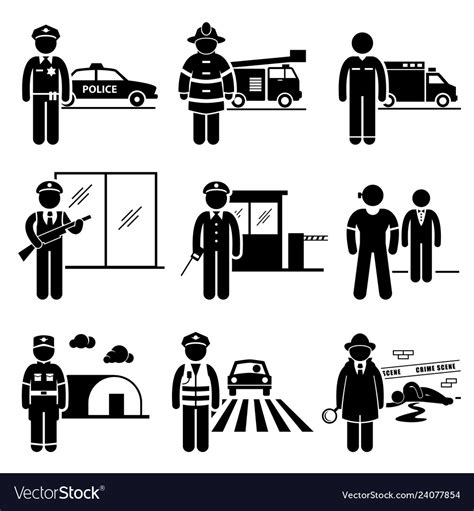In an increasingly complex and interconnected world, the demand for safety and security professionals is growing rapidly. From protecting physical assets to guarding against cyberattacks, these individuals play a vital role in safeguarding our homes, businesses, and communities.

Types of Safety and Security Jobs
The field of safety and security encompasses a wide range of professions, each with its own unique responsibilities and requirements. Some of the most common types of safety and security jobs include:
- Security Guards: Patrol buildings, grounds, and other areas to deter crime and ensure safety.
- Police Officers: Enforce laws, investigate crimes, and respond to emergencies within a community.
- Firefighters: Prevent and extinguish fires, rescue individuals from dangerous situations, and provide medical assistance.
- Security Analysts: Protect computer networks and systems from unauthorized access and cyberattacks.
- Safety Managers: Develop and implement safety programs to prevent accidents and injuries in workplaces or other environments.
- Loss Prevention Specialists: Identify and mitigate potential threats to retail businesses, such as shoplifting and fraud.
- Forensic Investigators: Collect and analyze evidence to solve crimes, including violent offenses, cybercrimes, and financial fraud.
Growing Demand for Safety and Security Professionals
According to the U.S. Bureau of Labor Statistics (BLS), the demand for safety and security personnel is expected to grow by 11% between 2020 and 2030, significantly faster than the average for all occupations. This growth is driven by several factors, including:
- Increased crime rates: The rising incidence of violent crime, property crime, and cybercrime has created a greater need for security professionals to protect individuals, businesses, and communities.
- Advancements in technology: The widespread adoption of technology, such as video surveillance systems and cybersecurity software, has led to new opportunities for professionals with expertise in these areas.
- Increased awareness of safety risks: Businesses and organizations are becoming more aware of the potential risks to their operations and are investing in safety and security measures to mitigate these risks.
Pain Points and Motivations
Safety and security professionals face a number of challenges and motivations in their work.
Pain Points:
- High stress: The nature of safety and security work can be inherently stressful, as professionals must remain vigilant and respond to emergencies on a regular basis.
- Physical and mental demands: Many safety and security jobs involve long hours, physical exertion, and exposure to dangerous situations.
- Limited career advancement opportunities: The path to promotion within safety and security professions can sometimes be limited.
Motivations:
- Protecting others: Safety and security professionals are driven by a desire to make a difference in the lives of others by preventing harm and ensuring safety.
- Job security: The growing demand for safety and security personnel provides professionals with job security and stability.
- Financial rewards: Many safety and security jobs offer competitive salaries and benefits packages.
Strategies for Success
To succeed in the field of safety and security, professionals should consider the following strategies:
- Obtain certifications: Earning industry-recognized certifications, such as those offered by the American Society for Industrial Security (ASIS) or the Board of Certified Crime Prevention Specialists (BCCP), can enhance credibility and career prospects.
- Develop technical skills: Proficiency in security technology, such as video surveillance systems, access control systems, and cybersecurity software, is increasingly important for safety and security professionals.
- Build relationships: Establishing relationships with law enforcement agencies, emergency responders, and other professionals in the safety and security industry can provide valuable information and support.
- Stay informed: Keeping up-to-date with industry trends, best practices, and new technologies is essential for safety and security professionals to remain effective.
FAQs
1. What is the average salary for safety and security professionals?
According to the BLS, the median annual salary for security guards is $32,770, for police officers is $67,290, and for fire inspectors is $63,240.
2. What are the educational requirements for safety and security jobs?
Many safety and security jobs require a high school diploma or equivalent, while others may require a bachelor’s degree in criminal justice, security management, or a related field.
3. Are safety and security jobs dangerous?
Some safety and security jobs, such as police officers and firefighters, can be inherently dangerous. However, many other safety and security jobs, such as security guards and loss prevention specialists, pose less risk of physical harm.
4. What are the career advancement opportunities for safety and security professionals?
Career advancement opportunities for safety and security professionals vary depending on the specific job and organization. Some common career paths include promotion to supervisor, manager, or director positions within the safety and security department.
5. Are there any safety and security jobs that work from home?
Some safety and security jobs, such as security analysts and forensic investigators, can be performed remotely. However, many other safety and security jobs require professionals to be physically present at their workplace.
6. What are some emerging trends in safety and security?
Emerging trends in safety and security include the use of artificial intelligence (AI) for threat detection and prevention, the development of smart security systems that can automate tasks, and the increasing integration of safety and security systems with other technologies, such as building management systems and video analytics.
